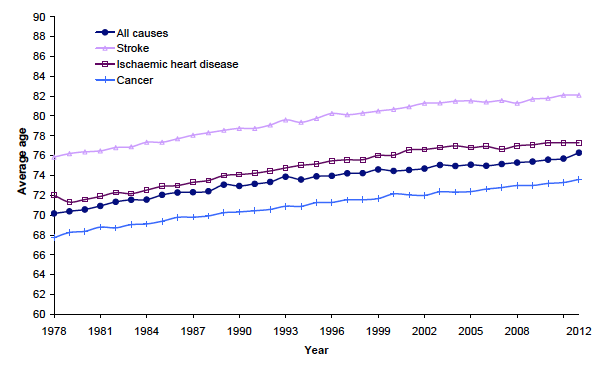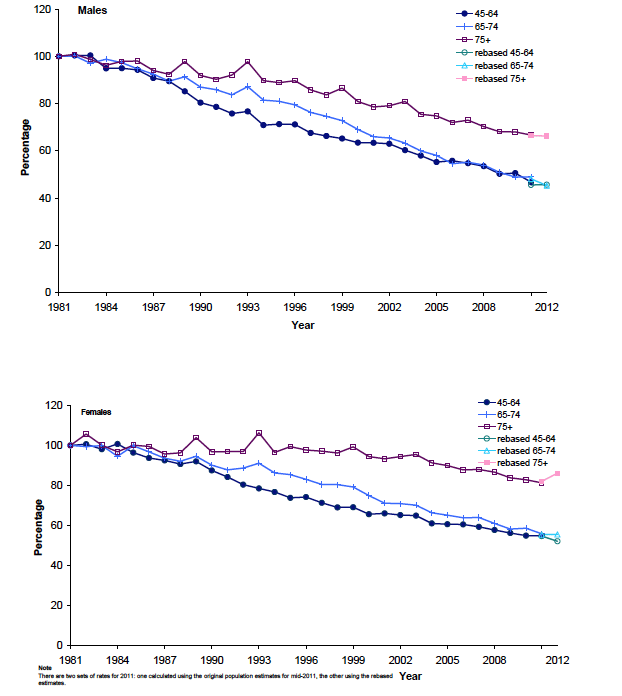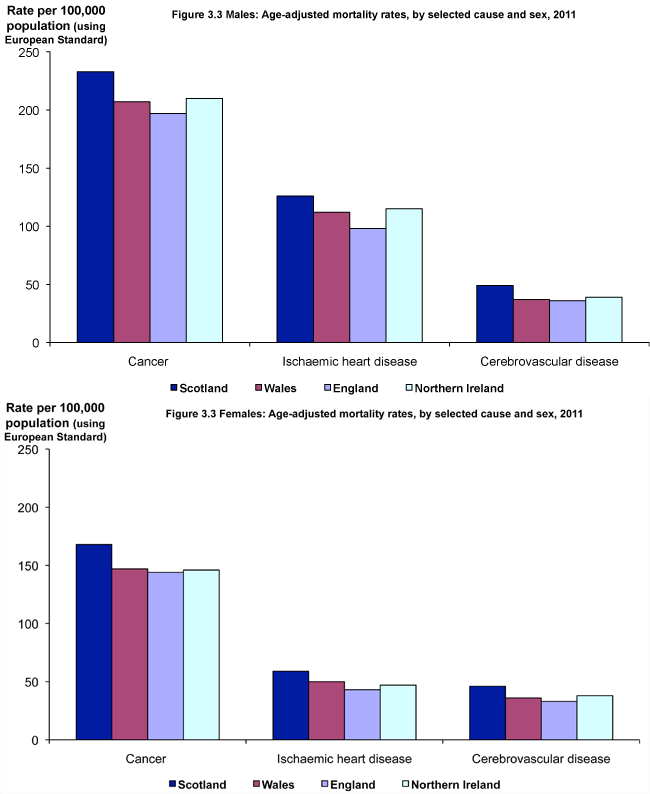
Numbers
54,937 deaths were registered in Scotland in 2012. This was 1,276 (2.4%) more than in 2011. It represented 10.3 deaths per 1,000 population in 2012.
Figure 2.1 shows that from 1951 up to the early 1990s the annual number of deaths remained relatively stable at about 60,000-65,000 a year. The total then declined slowly to 53,661 in 2011 which was the lowest total recorded since the introduction of civil registration in 1855. The overall 'crude' death rate (10.1 per 1,000 population) was also at its lowest recorded level in 2011. If the age distribution of the population is taken into account (using age-standardised death rates), then the fall in the death rate was even greater.
Causes of death
In 2012 more than half of all deaths were due to the so-called 'three big killers'. There were 15,864 deaths from cancer (29% of all deaths), 7,541 deaths from ischaemic (coronary) heart disease (14% of all deaths) and 4,475 deaths from strokes (8% of all deaths).
Since 1980, the total number of deaths from these causes has reduced, as shown in Table 3.1, falling from 65% of all deaths during 1980-82 and 1990-92, to 58% during 2000-02 and to 51% in 2012. The proportion of deaths caused by coronary heart disease has fallen from 29% in 1980-82 to 14% in 2012, and by strokes from 14% to 8%. However, the number of deaths from cancer rose by 14% (from an average of 13,903 per year in 1980-1982 to 15,864 in 2012); as a proportion of all deaths, it increased from 22% to 29% (mainly due to the 14% fall in the total number of deaths from all causes, from 64,050 per year in 1980-82 to 54,937 in 2012).
Death rates, by sex, for some of the most common causes of death are shown in Tables 3.2a and 3.2b.
Cancer
Of the 15,864 deaths from cancer in 2012, cancer of the trachea, bronchus and lung was the most common type, with 4,189 deaths (2,094 males and 2,095 females), accounting for over a quarter (26%) of all cancer deaths.
The next most frequent type of cancer death was prostate for men (881 deaths) and breast for women (1,063 deaths). Bowel cancer caused 1,648 deaths (844 males and 804 females) and cancers of the lymphoid, haematopoietic and related tissue caused 1,084 deaths (562 males and 522 females).
Table 3.2a shows that, over the last 25 years or so, male death rates from lung cancer have fallen by 32% (from 119 per 100,000 population in 1980-82 to 81 in 2012). By contrast, the rates for women, though still lower than those for men, have increased by 88% (from 41 per 100,000 population in 1980-82 to 77 in 2012).
Although overall death rates from cancer have risen since the start of the 1980s, from 291 (per 100,000 population) in 1980-82 to 310 for males and from 247 (per 100,000) in 1980-82 to 288 for females, they have actually fallen for those aged under 75. Table 3.2b shows that for men aged under 75 the rate fell from 214 (per 100,000 population) in 1980-82 to 170 in 2012, and for women aged under 75 it fell from 170 (per 100,000 population) in 1980-82 to 151 in 2012. The average age of death from cancer has risen (refer to figure 3.1), and the age-standardised death rate for cancer (which takes account of the change in the age-distribution of the population) has fallen by about a sixth since the start of the 1980s.
Heart disease and stroke
Table 3.2a shows that, in contrast to the rises for cancer, death rates for coronary heart disease (ischaemic heart disease) and stroke (cerebrovascular disease) have significantly declined. Between 1980-82 and 2012, rates for males fell by 60% for coronary heart disease and 53% for stroke, compared with reductions of 61 and 51% respectively for females. Table 3.2b shows that the improvement was proportionately greater for people aged under 75, with the coronary heart disease and stroke death rates falling by 71% and 74% respectively for males aged under 75. For females aged under 75 the improvement was greater at 79% for coronary heart disease and 75% for strokes.
Table 3.1: Number of deaths from selected causes, by sex, 1980-2012
| Cancer | Coronary (Ischaemic) heart disease | Stroke (Cerebrovascular disease) | Total deaths from these causes |
These causes as a % of all deaths | All deaths | ||||||
|---|---|---|---|---|---|---|---|---|---|---|---|
| Year | Males | Females | Males | Females | Males | Females | Males | Females | Persons | Persons | Persons |
| 1980-821 | 7,269 | 6,634 | 10,173 | 8,150 | 3,470 | 5,638 | 20,912 | 20,422 | 41,334 | 65% | 64,050 |
| 1990-921 | 7,664 | 7,324 | 8,964 | 7,846 | 2,913 | 5,029 | 19,541 | 20,199 | 39,740 | 65% | 61,168 |
| 2000-021 | 7,674 | 7,394 | 6,342 | 5,664 | 2,465 | 4,250 | 16,481 | 17,308 | 33,789 | 58% | 57,761 |
| 2012 | 7,978 | 7,886 | 4,258 | 3,283 | 1,686 | 2,789 | 13,922 | 13,958 | 27,880 | 51% | 54,937 |
1) Average over 3 year period.
Table 3.2a: Death rates from selected causes, by sex, Scotland, 1980-2012
| Males - rates per 100,000 population | |||||
|---|---|---|---|---|---|
| Cancer | Coronary (Ischaemic) heart disease | Stroke (Cerebrovascular disease) | |||
| Year | All types | Trachea, bronchus and lung | Prostate | ||
| 1980-821 | 291 | 119 | 19 | 408 | 139 |
| 1990-921 | 314 | 111 | 27 | 367 | 119 |
| 2000-021 | 315 | 93 | 32 | 261 | 101 |
| 2012 | 310 | 81 | 34 | 165 | 65 |
| Females - rates per 100,000 population | |||||
| Cancer | Coronary (Ischaemic) heart disease | Stroke (Cerebrovascular disease) | |||
| Year | All types | Trachea, bronchus and lung | Breast | ||
| 1980-821 | 247 | 41 | 45 | 304 | 210 |
| 1990-921 | 278 | 57 | 48 | 297 | 191 |
| 2000-021 | 281 | 64 | 43 | 216 | 162 |
| 2012 | 288 | 77 | 39 | 120 | 102 |
1) Average over 3 year period.
Table 3.2b: Death rates from selected causes, aged under 75, by sex, Scotland, 1980-2012
| Males aged under 75 - rates per 100,000 population | |||||
|---|---|---|---|---|---|
| Cancer | Coronary (Ischaemic) heart disease | Stroke (Cerebrovascular disease) | |||
| Year | All types | Trachea, bronchus and lung | Prostate | ||
| 1980-821 | 214 | 92 | 9 | 290 | 72 |
| 1990-921 | 210 | 79 | 11 | 231 | 50 |
| 2000-021 | 195 | 61 | 12 | 142 | 36 |
| 2012 | 170 | 48 | 10 | 84 | 19 |
| Females aged under 75 - rates per 100,000 population | |||||
| Cancer | Coronary (Ischaemic) heart disease | Stroke (Cerebrovascular disease) | |||
| Year | All types | Trachea, bronchus and lung | Breast | ||
| 1980-821 | 170 | 34 | 36 | 145 | 69 |
| 1990-921 | 175 | 42 | 34 | 115 | 46 |
| 2000-021 | 158 | 41 | 28 | 63 | 31 |
| 2012 | 151 | 44 | 24 | 30 | 17 |
1) Average over 3 year period.
Some other major causes of deaths
Other major causes of deaths registered in 2012 included:
National Records of Scotland (NRS) publishes a wide range of other statistics on causes of death. They are available from the relevant parts of our website (which include some background information on the basis of the statistics):
Mortality by age
The average age at death has increased fairly steadily for many years. Figure 3.1 shows that the average ages at death for cancer, heart disease and stroke have generally increased in line with the average for all deaths.
Figure 3.1: Average age at death, selected causes, Scotland, 1978-2012

About 63% of deaths in 2012 were of people aged 75 and over, and a further 18% were between the ages of 65 and 74. The relative stability in the total number of deaths over recent years masks significant reductions in age-specific mortality. Figure 3.2 shows, for both men and women, selected age-specific mortality rates over the last quarter of a century relative to the 1981 rates. The three age groups shown (45-64, 65-74 and 75 and over) accounted for 96% of all deaths in 2012. The minor breaks in the series at the figures for 2011 are due to the rebasing of the population estimates - please refer to the note.
At all these ages, there have been greater improvements in male than in female mortality. In the 45-64 age group, the death rates for men and women dropped by 54% and 48% respectively. In the 65-74 age group, males showed an improvement of 55% compared to 44% for females. The greatest differential is in the 75 plus age group, where male mortality has fallen by 34% compared to only 14% for females. These changes have narrowed the difference between female and (traditionally higher) male mortality.
Figure 3.2: Age specific mortality rates as a proportion of 1981 rate, 1981-2012

Geographical variations in mortality
Using 2010 data, the latest available, Figure 3.3 compares the death rates for the constituent countries of the UK for selected causes after adjusting for differences in age structure, by applying the European Standard Population age structure. The Scottish rates for cancer, ischaemic heart disease, and cerebrovascular disease (stroke) are well above the rates for the other countries of the United Kingdom, for both men and women.
Figure 3.3: Age-adjusted mortality rates, by selected cause and sex, 2011

Appendix 1, Table 3 shows the death rate for each of the European Union (EU) member states, and for some other countries in Europe. These are so-called 'crude' death rates. They are calculated by expressing the number of deaths per thousand population. As a result, they do not take account of differences in the sex and age structures of the countries' populations. All else being equal, a country with an unusually high proportion of its population in the younger age groups could have an unusually low 'crude' death rate. So, though the figure for Scotland is higher than those for most of the countries that are shown, this could to some extent be due to the structure of the Scottish population. A better way to compare Scotland's mortality with other countries' is to use the estimates of life expectancy for each country (please refer to Chapter 4).
Stillbirths, perinatal deaths and infant deaths
There were 274 stillbirths registered in Scotland in 2012. Stillbirths (where a child born after the 24th week of pregnancy does not breathe or show any other sign of life) are registered separately from live births and from deaths, and so are not included in either of those figures.
Perinatal deaths consist of stillbirths plus deaths in the first week of life (the latter are registered as live births and as deaths). There were 105 deaths of children who were aged under one week old, so there was a total of 379 perinatal deaths.
Infant deaths are deaths in the first year of life, all of which are registered as live births and as deaths. In total, 217 infant deaths were registered in Scotland in 2012 (including those who died in the first week of life).
Appendix 1, Table 1 on page 76 shows that in 2012 the stillbirth rate (4.7 per 1,000 live and still births) was at its lowest level ever recorded and the infant death rate (3.7 per 1,000 live births) was just fractionally above the 2010 rate, when the lowest level ever was recorded. Both rates have fallen greatly since the Second World War. The stillbirth rate has not fallen much in the past 30 years but the infant death rate has continued to decline over the same period.
Appendix 1, Table 3 on page 78 shows that the stillbirth rate for Scotland in 2012 (4.7) was lower than that for the UK as a whole (4.8) but higher than those of 23 of the then 27 European Union (EU) countries. The infant death rate for Scotland in 2012 (3.7) was below the UK rate (4.1) but higher than those of 18 of the 27 EU countries.
More information about death statistics
More detailed information about Scotland's deaths can be found in the Vital Events - Deaths section or the Vital Events Reference Tables of the NRS website.